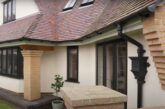
Tony Isaac, Sales Director at Brett Martin discusses the rooflight options available and explores some of the potential safety implications for residents and contractors.
Due to their angle in relation to the sun, a rooflight lets in twice as much daylight as an equivalent sized vertical window. As a result, rooflights are a great way to improve the natural lighting of a project, whether you are working on a new build, refurbishment or extension. However, due to their location, there are serious safety implications to consider when specifying and installing rooflights.
When looking to specify a rooflight, there are two primary choices of glazing for domestic projects: laminated and toughened glass. Both are considered a type of ‘safety glass’ because – unlike standard float glass – they have been engineered to resist breaking as much as possible.
Furthermore, when they do break, they do so in a way that minimises risk for anyone in proximity. However, there are significant differences in how the two types of glass can break, with toughened glass still posing a potential health risk when used in a rooflight that could break overhead.
Toughened glass

Toughened glass is made from float glass which has been exposed to heat after the panes have been formed. The glass is uniformly exposed to temperatures of over 600°C as it passes through a furnace before being rapidly cooled or quenched. This process, known as tempering, makes the glass considerably stronger than conventional float glass.
However, whilst toughened glass is highly resistant to impacts compared with standard glass, it can be broken with a focused impact from metal object, such as the foot of ladder, or if the edges are damaged during transportation or installation – posing a danger to the contractor. Poorly manufactured toughened glass is also susceptible to thermal stresses, which has resulted in panes ‘popping’ seemingly without cause. Furthermore, should the pane break, the entire piece shatters, causing small pieces of glass to rain down into the room below.
Laminated glass

Laminated glass, on the other hand, is made from two panes of float glass with a polymer layer bonded between them. Unlike toughened glass, laminated glass does not shatter into individual pieces on impact because the polymer layer holds the broken glass together. As a result, laminated glass often remains in-situ, the broken panes forming a characteristic spider’s web shape, keeping occupants below safe from falling debris.
A good example of the difference between the two types of safety glass can be found in cars. Most people are familiar with the experience of a cracked laminated glass windscreen, which stays in situ, compared to the mess created by the breakage of a toughened glass side window.
Best Practice
Industry-acknowledged best practice is that laminated glass should be used, with The Rooflight Association recommending that the best solution is a double glazed rooflight that combines a toughened outer and a laminated inner pane. It should also be noted that a laminated inner pane is always required under the regulations if the rooflight is placed more than five metres above floor level and the window has an area of more than three metres squared. Being armed with this information ensures installers are better equipped to give homeowners better advice on the best products for their home.
Brett Martin’s double-glazed Roof Lantern and Flat Glass Rooflights, for example, utilise toughened glass for the outer pane and laminated glass for the inner as standard on all products. This provides dual benefits, protecting anyone who may need to access the flat roof from above from falling through and protecting residents inside from the risk of broken glass. This glazing combination, with a 90% argon filled cavity, results in a highly thermally efficient rooflight as well as safe, sleek and modern one. Available as a circular, linked or single rectangular rooflight, Brett Martin offers over 100 size options across the range, as well as bespoke units so that the ideal solution can be specified for any project.
It is imperative to ensure that the safety of residents and contractors is the priority when specifying and installing rooflights. Toughened glass alone does not guarantee the safety most homeowners expect, and so laminated solutions should be considered as an extra line of defence against accidental breakage.
To find out more about Brett Martin’s range of laminated glass rooflights visit https://www.brettmartin.com/daylight-systems/our-products/glass-rooflights







